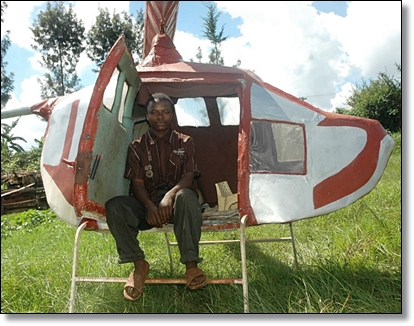Education in Kenya: Liberating or Shackling?

 |
| Mr Mwangi with his 'innovation' Photo courtesy |
Data available from the Commission for University Education shows that Kenya has 22 Public Universities, 17 Chartered Private Universities and 12 Universities with Interim Letters of Authority. In addition there are 18 constituent university colleges and satellite campuses as well as 33 Technical Industrial Vocational and Entrepreneurship Training (TIVET) colleges. Although these institutions train thousands of graduates in almost every conceivable academic, technical and artistic discipline, Kenya is still mired in perennial problems of endemic poverty, disease, hunger and under-development.
Why is a country with so many educated and trained people unable to eradicate or ameliorate problems such as poverty, hunger, preventable diseases, floods, drug and substance abuse inter alia? Or even better, why is Kenya a net importer of capital and consumable goods yet the country is not short of skilled labour or venture capital. The massive investments in government securities, corporate bonds and Initial Public Offers (IPOs) at the Nairobi Stock Exchange (NSE) display an enterprising society with a desire to achieve financial progress and socio-economic development. But what is preventing an industrial take-off in this country? A disparity between our education system and national development plans is to blame.
The overly ambitious Vision 2030 lists education and training at the top of social welfare programmes intended to improve the quality of life for Kenyans. Its economic pillar ranks manufacturing and information technology among the six priority sectors that will spur economic growth, create employment and improve prosperity throughout Kenya. Now in its 5th year Vision 2030 can boast of some infrastructural development projects but very little to do in terms technological innovation and manufacturing which are requisite for an industrial take-off.
The Kenyan media is not short of stories of novel ideas and inventions mostly by mechanics, jua kali artisans and ordinary folks with very minimal exposure to higher education or training in universities and TIVETs. Peter Wambugu a former mechanic in Nanyuki created and patented “Wambugu Apple” with the assistance of the Kenya Agricultural Research Institute (KARI). Richard Turere a 13 year old boy from Kajiado County created a Light-emitting Diodes (LEDs) system to protect his father’s animal herd from marauding lions. These innovators used very basic materials available in their immediate environment to “create” or discover. Mwangi’s enterprise cost him Sh. 57,000/-, a very tidy sum for a farm-hard. Many professors and graduates in engineering, physical and natural sciences from our universities and TIVETS earn much more but can hardly demonstrate any meaningful creation or invention. The difference between jua kali inventors like Turere, Mwangi, Wambugu and the highly educated graduate engineers is that the former belong to a group which dares to dream. Shut out of the formal employment by an antiquated education system that emphasizes more on scholastic papers rather than the development of real-life skills, people like Mwangi, Turere and Wambugu are forced by circumstances to think out of the box and exploit their natural instincts and immediate environment to survive and progress. After all, necessity is the mother of invention.
Our current formal education system hardly stimulates inventive reflection in graduates because it is highly oriented to passing examinations and acquiring academic papers. The government and private enterprise have not helped either. They insist on academic papers to hire their workforce. Innovation and entrepreneurship are accorded low or no consideration at all in formal employment. Highly educated graduates are therefore inclined to look for jobs rather than “work” yet agricultural and industrial production requires people with real life skills and a disposition to do actual physical tasks. The elevation of Technical Training Colleges into universities is therefore denying this country a skilled human capital segment which is vital for industrial innovation and production.
The new government should drastically reform the education sector and ensure that there is a shift from time-bound, curriculum-based training to flexible and competency-based training and the re-orientation of our universities and TIVETs from supply–led training to demand-driven training. The likes of Mwangi, Turere and Wambugu could benefit from these reforms which are also envisaged by The Technical and Vocational Education and Training Bill, 2012 which is still pending in Parliament. When he was the Minister of the Higher Education, Science and Technology H.E. William Samoei Ruto the Deputy President had suggested a reduction in the number of slots and funding for courses in humanities and social sciences in public universities. He was right and now he can actualize this plan by ensuring that the person who is nominated to manage the Education docket is competent enough to re-engineer the current education system and make sure that all our schools and institutions of higher training produce graduates whose set of skills are properly aligned to the strategic themes under Vision 2030.
By Capt. (Rtd) Collins Wanderi,
Advocate, Commissioner for Oaths, Notary Public. Chair- Institute of Forensic Auditors (KeIFA).
